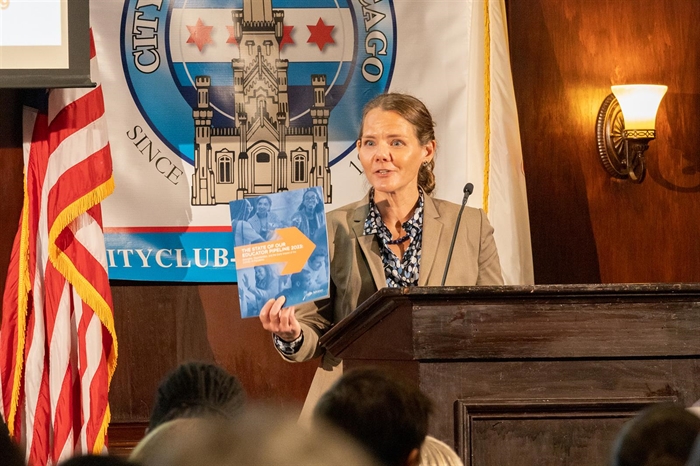Report: Illinois’ educator workforce weathered pandemic, but persistent issues remain

SPRINGFIELD – The supply of education professionals continues to improve in Illinois despite strains brought on by the COVID-19 pandemic, but persistent issues remain in certain regions of the state and within some teaching fields.
That’s the conclusion of a new report by the education advocacy group Advance Illinois, which was instrumental in the 2017 passage of the state’s Evidence-Based Funding formula that overhauled the way state funds public education.
“This is really critical for children,” Advance Illinois president Robin Steans said in an interview for the Capitol Cast podcast. “There’s literally nothing more important that we do as a state than to make sure that we’ve got effective teachers in every classroom, in front of every child. And if we get that wrong, if there are gaps, if there is turn, if there is attrition, all of those things, negatively affect kids.”
Even before the pandemic, Illinois was experiencing shortages of teachers, administrators and paraprofessionals, although the shortages weren’t distributed evenly across the state or across all teaching areas. Then, as schools closed during the pandemic and later went to hybrid systems of remote and classroom teaching, there were concerns that even more educators would opt to leave the profession altogether.
However, the Advance Illinois report suggests the post-pandemic workforce remains largely intact.
It shows the number of teachers, assistant principals and paraprofessionals working in Illinois schools has been growing steadily since well before the pandemic and is now at its highest level in the past decade. And that growth has been seen in all regions of the state and across districts of different funding levels.
That finding is also reflected in the most recent state report card from the Illinois State Board of Education, which shows the statewide average student-teacher ratio was 17:1 at the elementary level, a 10.6 percent improvement from five years ago. At the high school level, the student-teacher ratio was 18:1, an 8.4 percent improvement from 5 years ago.
Teachers also increasingly don’t look like the students they teach. Fifteen years ago, there was a 31 percentage point gap between the percentage of white teachers compared to the percentage of white students. Last year, that number had risen to a 35-point gap, meaning that the state’s student population is diversifying at a faster rate than the teacher workforce.
Teachers are less diverse than the students they teach
In Illinois, 83.1 percent of teachers are white, compared to 46.4 percent of students, according to state data from the 2022-2023 school year. And over the past 15 years, Illinois students have gotten more diverse at a faster rate than their teachers.
This, according to Advance Illinois, can have detrimental effects – academic and otherwise – on students of color.
But those are statewide averages and they may not reflect conditions in all classrooms and in all subject areas.
According to the Advance Illinois report, nearly half of all school districts in Illinois reported having at least one teacher vacancy during the 2022-2023 school year, with the most acute shortages occurring in urban and remote rural districts. Urban and remote rural districts also had the highest concentrations of vacant special education teacher positions and paraprofessional positions.
The report also suggests that since the pandemic, districts have had particular trouble finding enough substitute teachers and paraprofessionals.
“I think that tracks with some of what we’re seeing in other sectors of the economy,” Steans said. “I think the people who are more on the minimum wage end of the spectrum, that’s just been more of a crunch. And I think part of the response to that is going to need to be to increase compensation and other kinds of work-related benefits.”
Teacher attendance fell significantly when schools returned to in-person instruction
Student attendance fell by 1.9 percent when schools returned to in-person instruction. Teacher attendance fell by 22.9 percent. This decrease placed strain on the state’s substitute teacher workforce.
The report notes that during the pandemic, schools in Illinois benefited greatly from federal disaster relief money, known as Elementary and Secondary School Emergency Relief funds, or ESSER.
According to ISBE, Illinois schools have received nearly $8 billion in ESSER funds since the pandemic began, and more than a third of that money – $1.7 billion – was used to fund salaries. But those funds are scheduled to expire next year, which means school districts will face some difficult budget decisions if they want to maintain all of the positions they currently fund.
Steans said she believes schools should be able to absorb the loss of that federal funding as long as the state continues to fully fund the Evidence-Based Funding formula, the 2017 law that calls for $350 million in additional school funding each year, with the bulk of that money going to the least-funded districts.
“It’s really hard for me to believe that all of those dollars are going to go away, and we’re not going to see some contraction,” Steans said. But it’s possible that will be minimal. I think we’re really just going to have to wait and see.”
Rep. Carol Ammons, D-Urbana, said Advance Illinois’ research is a tool for lawmakers and the organization often acts as a go-to think tank on education issues for policymakers.
“It really does provide us with the fodder of data so that we can see a real picture of what’s going on post-policy,” she said. “We pass a law, they look at it. We pass a law, they look at it. To me as a lawmaker, that’s critical.”
Ammons was in Chicago on Thursday to speak at the launch event for the nonprofit’s new report at a banquet sponsored by the City Club of Chicago, which regularly attracts prominent policy advocates and business leaders.
Thursday’s event drew an influential mix of government officials, including several members of the Pritzker administration, four state lawmakers and former Senate President John Cullerton – who now sits on Advance Illinois’ board of directors.
In a panel discussion between Ammons, ISBE Chief of Staff Kimako Patterson and 2023 Teacher of the Year Briana Morales, the three focused on inequities as a driving force for reform.
“When we talk about a teacher shortage, we’re talking about an equity issue…,” Patterson said. “It is imperative that we continue to focus the support where it’s needed.
Ammons later echoed that sentiment, saying that paraprofessional and principal workforce development are important topics when considering how to address educational inequity.
Capitol News Illinois is a nonprofit, nonpartisan news service covering state government. It is distributed to hundreds of print and broadcast outlets statewide. It is funded primarily by the Illinois Press Foundation and the Robert R. McCormick Foundation, along with major contributions from the Illinois Broadcasters Foundation and Southern Illinois Editorial Association. Muddy River News also supports their mission.
Miss Clipping Out Stories to Save for Later?
Click the Purchase Story button below to order a print of this story. We will print it for you on matte photo paper to keep forever.

